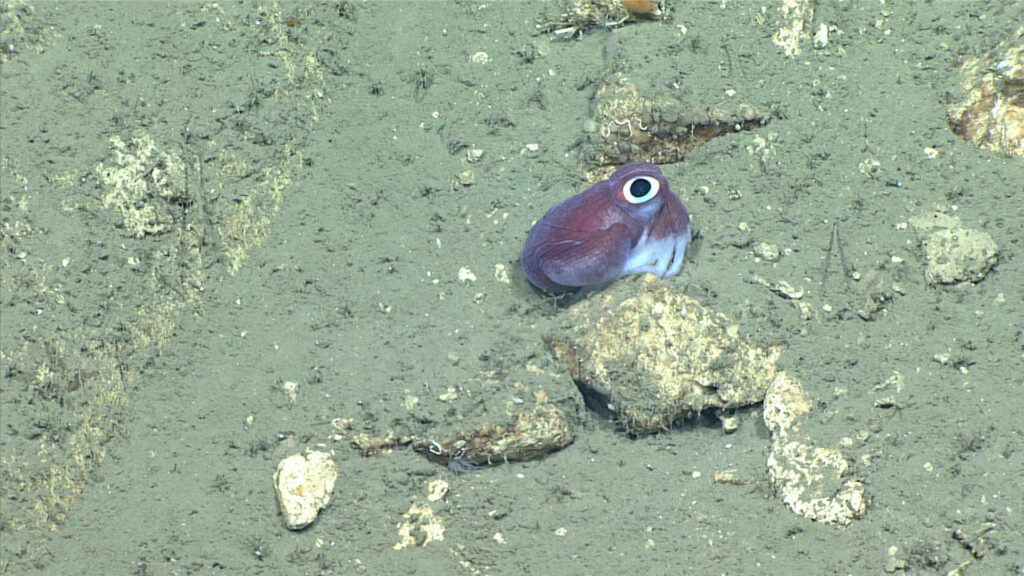The bobtail squid is a unique species that has a symbiotic bacteria that is bioluminescent. Let’s start off by understanding what symbiotic relationship is. Symbiotic relationship is define as, “Long-term interaction between organisms of at least two different species, often comprised of a large host and one or two species of microbe. For the host and/or microbes, one, both, or neither species may benefit from the relationship (Young, 2018).” For the specific symbiotic relationship between the bobtail squid and the bacteria we can consider it a mutualism relationship because both the host and microbe benefits from the relationship. We will get into how their relationship benefits both the bobtail squid and the bacteria and then we will get into the anatomy/physiology aspect of their relationship and how it all works together.
The bobtail squid also scientifically known as Euprymna scolopes, is a small nocturnal squid that lives in shallow coastal waters specifically in the Pacific Ocean. The bobtail squids size can be up to 3 cm and since it’s so small it spends its life hiding from predators. This species adapted to defense mechanisms as well to have higher chance of survival as a high threat prey. It’s main defense mechanism is camouflage, during the day it stays hidden in the sand by burying itself and this is usually when it sleeps and at night the bioluminescent bacteria allows it to stay camouflage by being able to match the reflection of the moonlight hitting the water making it almost invisible to predators at night. Even though the camouflage main goal is to protect them from predators it also allows them to be able to sneak up on smaller shrimps and crustaceans to eat them. Bobtail squid are r-selected species meaning they live only up to 10 months and have no parental care because once females lay hundreds of eggs they end up dying shortly after.
The bioluminescent bacteria scientifically known as Vibrio fischeri, is a rod shape bioluminescent bacteria that consist of two chromosomes in its bacterial genome with low G-C content and contains plasmid(s). This bacteria is also not restricted to the bobtail squid environment and has a flexible metabolic system. However, the benefits from the bobtail squid allows the bacteria to be provided with nutrients, protection, and for the bacteria to grow and reproduce. Even though the trade off for nutrients and protection is using energy to provide light for them organism. Overall the squids benefits outweighs the tradeoffs.
To dive deeper into their relationship let’s focus on the life cycle of the bobtail squid. Bobtail squids hatch without the bioluminescent bacteria but will obtain it shortly after from the seawater. The bobtail squid houses the bacteria in a specialized light organ whose anatomy resembles a simplified eye with ciliated surfaces for recruitment, pores, and ducts leading to crypts where the symbionts live. The optical tissues then shapes their bioluminescence for nighttime camouflage. Once the bacteria enters the light organ, bacterial MAMPs and light production triggers developmental changes in the host, including regression of the ciliated fields, remodeling of the crypt epithelium, and shifts in immune gene expression. Without the bacteria studies show that the squids light organ won’t develop properly. The cycle of the squid repeats everyday with the squid releasing most of its symbionts and then the remaining bacteria reproduce during the day so they have enough to be able to allow the squid to glow at night.
Across its life cycle, the squid relies on the symbiotic relationship for camouflage and the bacteria relies on the symbiotic relationship to gain a protected niche and a mechanism for dispersal. This is why this symbiotic relationship is so fascinating and is continued to be studied by scientists today. This symbiosis relationship is a perfect example for studying microbial selection, immune modulation, development, and host–microbe coevolution.
Img 1: This image shows a picture of a bobtail squid seen on a diving expedition in Hudson Canyon the year 2021. This image will help visualize what the species look like to get a better understanding of the text.

